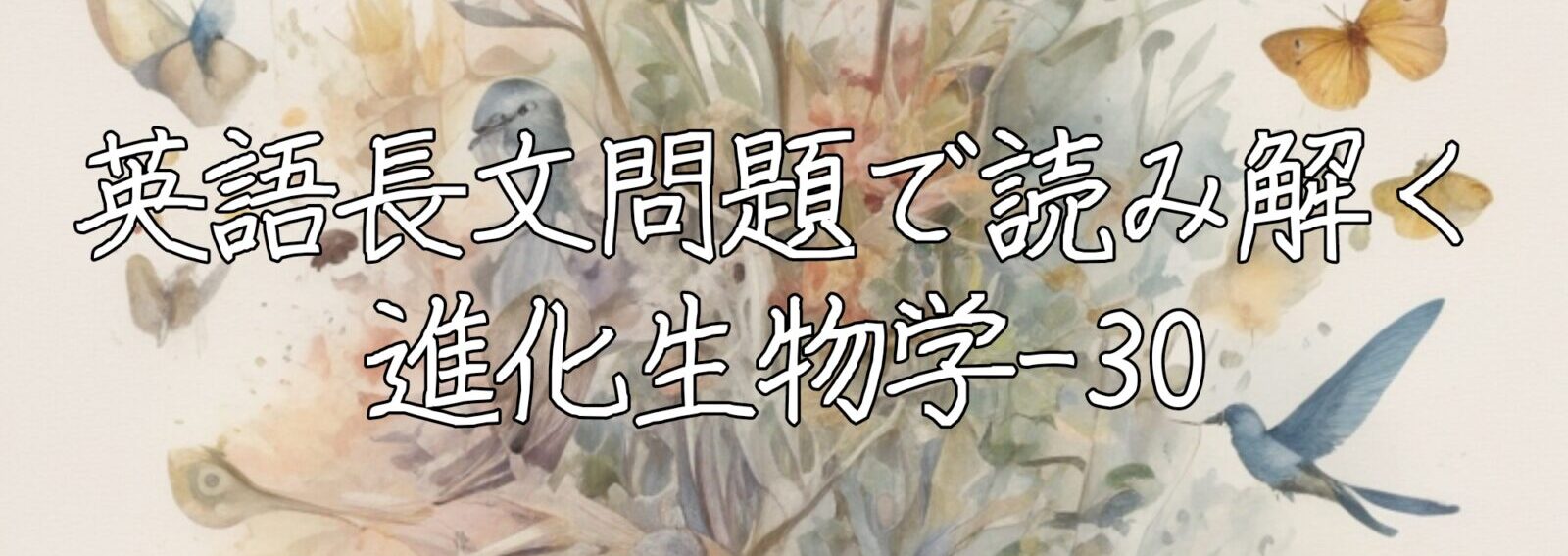英検2級レベルの英語長文問題を読み解きながら、進化生物学の基本的な知識を身につけることが出来る問題集をkindleにて出版しました!
各種英語検定試験の対策にもなる、専門的な英語長文の読解力を向上できる問題集になっています。
これまでに発売した英語の長文問題集の一覧はコチラから!
英語長文で読み解く進化生物学-30 の中身を公開!
以下、どんな内容になっているのかを公開します!
目次
はじめに
1.自然選択 – 環境に適応した個体が生存・繁殖しやすくなる過程。
2.適応 – 環境に対する生物の形態や行動の進化的変化。
3.突然変異 – 遺伝子の変異による新しい形質の出現。
4.遺伝的浮動 – 小集団内での遺伝子頻度のランダム変動。
5.遺伝的多様性 – 集団内の遺伝子の多様性。
6.収斂進化 – 異なる系統が似た形質を持つようになる現象。
7.共進化 – 二つ以上の種が互いに影響を及ぼし合いながら進化すること。
8.適応放散 – 一つの祖先から多様な形態・生態を持つ種が生じること。
9.系統樹 – 種の進化的関係を示す図。
10.共通祖先 – 複数の種が共有する祖先。
11.進化的安定戦略 – ある戦略が普及すると他の戦略が侵入できなくなる状態。
12.遺伝的相同性 – 遺伝子配列の類似性。
13.生態的地位 – 種が生態系内で占める役割や位置。
14.遺伝子流動 – 集団間での遺伝子の移動。
15.ボトルネック効果 – 集団の急激な縮小による遺伝子多様性の減少。
16.創始者効果 – 少数の個体が新しい集団を作る際の遺伝子多様性の減少。
17.進化的もつれ – 複数の形質が進化的に絡み合う現象。
18.進化的制約 – 進化の可能性を制限する要因。
19.進化的トレードオフ – 一つの形質の進化が他の形質に悪影響を及ぼすこと。
20.進化的ゲーム理論 – 生物間の相互作用をゲーム理論で解析する方法。
21.微進化 – 小規模な遺伝的変化。
22.マクロ進化 – 大規模な進化的変化。
23.系統解析 – 種の進化的関係を解析する方法。
24.化石記録 – 化石に基づく生物の進化の記録。
25.進化のパターン – 進化の様々なパターン(例:分岐進化、平行進化)。
26.進化のメカニズム – 進化を引き起こすメカニズム(例:自然選択、遺伝的浮動)。
27.適応的景観 – 遺伝的変異と適応度の関係を示す概念。
28.進化の歴史 – 生物の進化の歴史。
29.進化生態学 – 生態系における進化の役割を研究する学問。
30.進化遺伝学 – 遺伝学に基づく進化の研究。
1.自然選択 – 環境に適応した個体が生存・繁殖しやすくなる過程。
The Power of Natural Selection: Nature’s Guiding Hand
Natural selection is a fundamental concept in evolutionary biology, first proposed by Charles Darwin in the 19th century. It explains how populations of organisms change over time, adapting to their environments. This process is often described as “survival of the fittest,” but it’s important to understand that “fittest” doesn’t necessarily mean the strongest or fastest. Instead, it refers to the organisms best suited to their specific environment.
At its core, natural selection works through four main principles: variation, inheritance, competition, and survival. Let’s explore each of these using examples from nature.
Variation refers to the differences between individuals in a population. For instance, in a group of beetles, some might be green, others brown. Some could be larger, others smaller. This variation is crucial for natural selection to occur.
Inheritance is the passing of traits from parents to offspring. If those green beetles tend to have green offspring, and brown beetles tend to have brown offspring, then we have inheritance of traits.
Competition occurs because resources in nature are often limited. Organisms must compete for food, water, space, and mates. In our beetle example, if the environment has more green leaves, the green beetles might be better camouflaged and thus more likely to survive predation.
Survival and reproduction are the final steps. The organisms best suited to their environment are more likely to survive and reproduce, passing their beneficial traits to the next generation. Over time, this can lead to significant changes in a population.
A classic example of natural selection in action is the peppered moth in England. Before the Industrial Revolution, most of these moths were light-colored, which helped them blend in with light-colored tree bark. However, as pollution darkened the trees, darker moths became more common because they were better camouflaged against the now-sooty bark. This change in the moth population over time is natural selection at work.
Natural selection can lead to adaptation, where organisms become better suited to their environment over generations. The long neck of the giraffe is a good example. Giraffes with slightly longer necks could reach higher leaves, giving them an advantage in times of food scarcity. Over many generations, this led to the extremely long necks we see in giraffes today.
It’s important to note that natural selection doesn’t have a goal or direction. It simply favors traits that are beneficial in a specific environment at a specific time. If the environment changes, different traits might become advantageous.
Natural selection can also lead to co-evolution, where two species evolve in response to each other. The relationship between flowering plants and pollinators is a good example. As plants evolved more complex flowers, insects evolved more specialized features to access the nectar, resulting in the wide variety of flowers and pollinators we see today.
Sometimes, natural selection can be surprisingly rapid. The Grants, a pair of evolutionary biologists, observed significant changes in the beak sizes of Galápagos finches over just a few years in response to changes in their food supply. During a drought, when only larger, tougher seeds were available, finches with larger, stronger beaks were more likely to survive and reproduce.
Natural selection doesn’t just affect physical traits; it can also influence behavior. For example, in some bird species, males perform elaborate dances to attract mates. The most impressive dancers are more likely to reproduce, passing on their dancing ability to their offspring.
In conclusion, natural selection is a powerful force shaping the diversity of life on Earth. It explains how species adapt to their environments over time and provides a framework for understanding the incredible variety of life forms we see around us. As environments continue to change, often due to human activities, understanding natural selection becomes increasingly important for conservation efforts and predicting how species might respond to these changes.
注釈
- Natural selection (自然選択): 生物が環境に適応して進化する過程
- Evolutionary biology (進化生物学): 生物の進化を研究する学問
- Adaptation (適応): 生物が環境に合わせて変化すること
- Variation (変異): 同じ種の中での個体差
- Inheritance (遺伝): 形質が親から子に受け継がれること
- Competition (競争): 資源をめぐる生物間の争い
- Camouflage (カモフラージュ、擬態): 周囲の環境に溶け込むこと
- Predation (捕食): ある生物が他の生物を餌として食べること
- Industrial Revolution (産業革命): 18世紀後半から19世紀にかけて起こった大規模な産業の変革
- Co-evolution (共進化): 2つの種が互いに影響し合いながら進化すること
- Pollinator (送粉者): 花粉を運ぶ昆虫や動物
- Drought (干ばつ): 長期間雨が降らず、水不足になる状態
設問
- What is the main concept discussed in the passage?
a) Artificial selection
b) Natural selection
c) Genetic engineering
d) Spontaneous generation - Which of the following is NOT one of the four main principles of natural selection mentioned in the passage?
a) Variation
b) Inheritance
c) Mutation
d) Competition - In the example of the peppered moth, what caused the shift in the moth population?
a) A sudden increase in predators
b) Changes in the color of tree bark due to pollution
c) The introduction of a new species of moth
d) A genetic mutation that made dark moths more fertile - How does the passage describe the term “fittest” in the context of natural selection?
a) The strongest organisms
b) The fastest organisms
c) The organisms best suited to their environment
d) The largest organisms - What example does the passage use to illustrate adaptation through natural selection?
a) The long neck of giraffes
b) The colorful feathers of peacocks
c) The sharp teeth of sharks
d) The wings of bats - According to the passage, what is co-evolution?
a) When two species become extinct at the same time
b) When two species evolve to become the same species
c) When two species evolve in response to each other
d) When two species stop evolving - What did the Grants observe in their study of Galápagos finches?
a) The finches stopped evolving
b) The finches developed new colors
c) Rapid changes in beak sizes in response to food supply changes
d) The finches learned to fly longer distances - How does the passage describe the role of natural selection in behavioral traits?
a) It has no effect on behavior
b) It can influence behaviors like mating dances
c) It only affects physical traits, not behavior
d) It makes all animals behave the same way - According to the passage, why is understanding natural selection important today?
a) To create new species in laboratories
b) To predict lottery numbers
c) For conservation efforts and predicting species’ responses to environmental changes
d) To stop all evolution - Which statement best reflects the passage’s description of natural selection’s “goal”?
a) Natural selection aims to create the perfect organism
b) Natural selection has the goal of increasing biodiversity
c) Natural selection doesn’t have a goal or direction
d) Natural selection aims to make all organisms the same
解答・解説
- 本文で主に議論されている概念は何ですか?
a) 人為選択
b) 自然選択
c) 遺伝子工学
d) 自然発生
答え:b) 自然選択
説明:本文全体が自然選択について説明しています。冒頭の段落で「自然選択は進化生物学の基本的な概念であり、19世紀にチャールズ・ダーウィンによって初めて提唱されました」と明確に述べられています。
- 以下のうち、本文で言及されている自然選択の4つの主要原理に含まれないものはどれですか?
a) 変異
b) 遺伝
c) 突然変異
d) 競争
答え:c) 突然変異
説明:本文の2段落目で、自然選択の4つの主要原理として「変異、遺伝、競争、生存」が挙げられています。突然変異は言及されていません。
- オオシモフリエダシャクの蛾の例では、蛾の個体群の変化の原因は何でしたか?
a) 捕食者の突然の増加
b) 汚染による木の樹皮の色の変化
c) 新種の蛾の導入
d) 暗色の蛾をより繁殖力の高くする遺伝的突然変異
答え:b) 汚染による木の樹皮の色の変化
説明:本文中で「産業革命により汚染が木を暗くしたため、暗色の蛾がより一般的になりました。なぜなら、彼らは今や煤けた樹皮によりよく擬態できたからです」と説明されています。
- 本文では、自然選択の文脈で「最も適した」という用語をどのように説明していますか?
a) 最も強い生物
b) 最も速い生物
c) 環境に最も適した生物
d) 最も大きな生物
答え:c) 環境に最も適した生物
説明:本文の冒頭近くで、「『最も適した』は必ずしも最強や最速を意味するわけではありません。むしろ、特定の環境に最も適した生物を指します」と明確に述べられています。
- 本文では、自然選択による適応を説明するためにどの例を使用していますか?
a) キリンの長い首
b) クジャクの色鮮やかな羽
c) サメの鋭い歯
d) コウモリの翼
答え:a) キリンの長い首
説明:本文中で「キリンの長い首は良い例です」と述べられ、キリンの首の長さが自然選択によってどのように進化したかが説明されています。
と、このような感じで、30問の長文問題が一冊にまとまっております!
進化生物学の重要テーマ、30問あります!
目次にもあるように、30個の進化生物学にまつわる重要テーマやキーワードを使い、長文問題を作りました。
英語力を向上させたい、かつ、進化生物学の知識を得たい人にとって、最適な長文問題集となっております。もちろん、英語で進化生物学を学びつつ、英語力を向上させてもいいでしょう!
英語レベルは英検2級を目指している人にとって丁度いい塩梅。
タイパを重視して、進化生物学の知識を得つつ、英語の読解力を向上させたい人は、ぜひ活用してみてください。
これまでに発売した英語の長文問題集の一覧はコチラから!
#Kindle本 #Kindle出版 #Kindle電子書籍 #英語 #英語長文問題集 #英検対策 #英語資格試験対策 #長文問題 #進化生物学





-320x180.jpg)






コメント